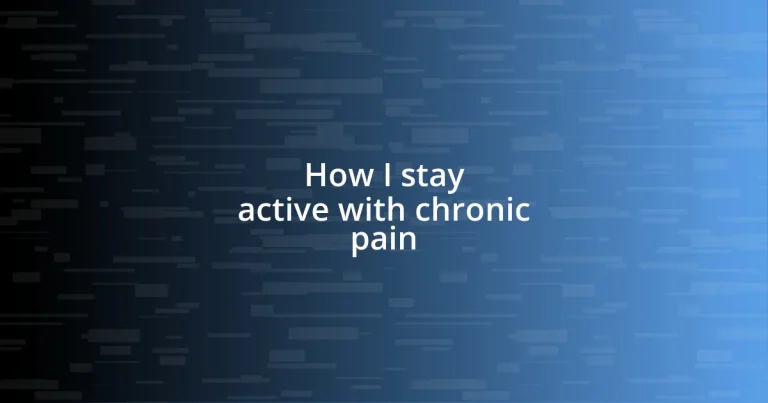Key takeaways:
- Chronic pain management involves both physical strategies, like gentle exercises, and mental techniques, emphasizing the importance of emotional well-being.
- Staying active through low-impact exercises (e.g., swimming, yoga) boosts mood, energy, and overall health without exacerbating pain.
- Listening to body signals and adapting activities during flare-ups allow for continued movement and joy, making pain management more sustainable.
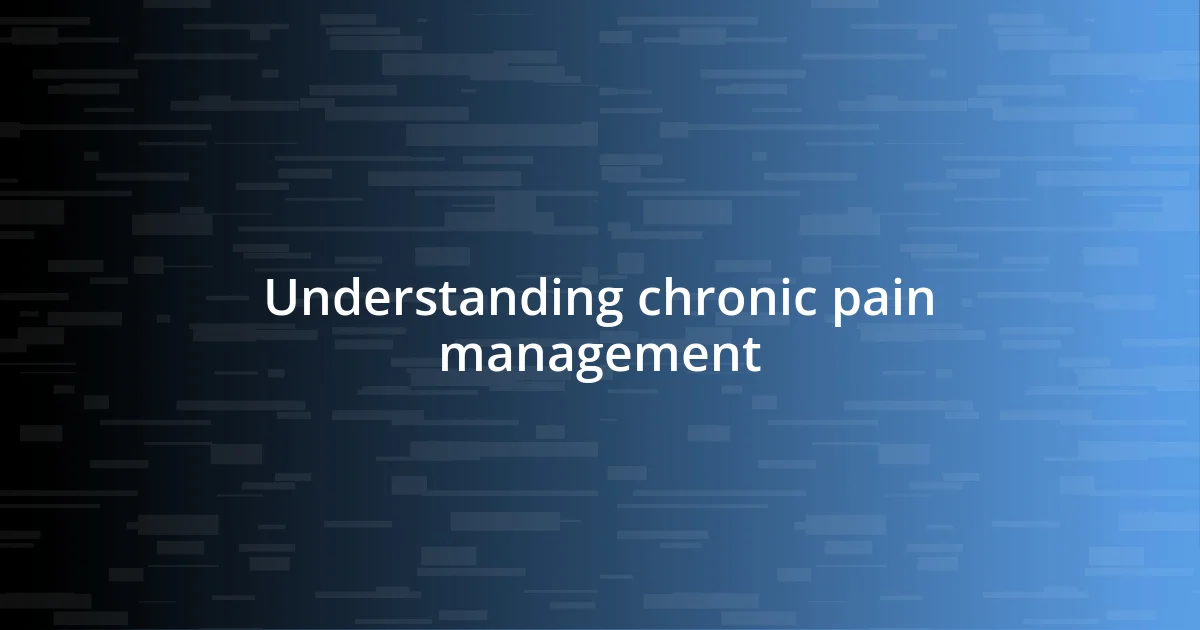
Understanding chronic pain management
Chronic pain management is not just about finding ways to alleviate discomfort; it’s about understanding the intricate dance between the mind and body. I often find myself asking, “How can I navigate through this pain today?” It’s a question that really resonates because the answer changes daily. Sometimes, it’s about physical strategies like gentle stretches, while other times, it’s about mental techniques, such as deep breathing or mindfulness.
Emotions play a huge role in how we experience pain. I vividly remember a day when I woke up feeling particularly low, and I could feel the heaviness of that emotional state amplifying my physical discomfort. In those moments, there’s a clear connection: managing mental health is just as crucial as addressing physical symptoms. How often do we overlook the emotional toll chronic pain takes on us? It’s vital to recognize that this emotional awareness can lead to more effective pain management strategies.
In my journey, I’ve discovered that keeping a pain diary can be a powerful tool. I track my activities, emotions, and pain levels, and over time, I noticed patterns that helped me identify triggers. This simple practice not only provides insight but also empowers me to take proactive steps in my pain management. Isn’t it interesting how something so small can lead to significant changes in our approach to pain? Embracing such methods has made an enormous difference in my life, giving me a sense of control and understanding over my chronic pain.
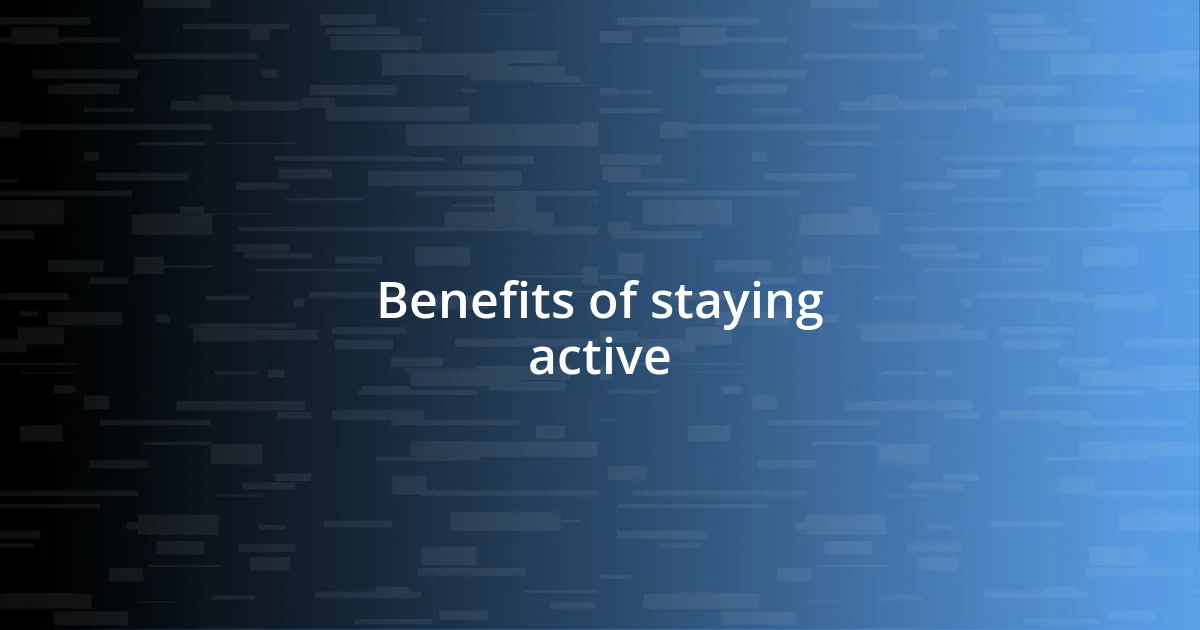
Benefits of staying active
Staying active, despite chronic pain, brings a multitude of benefits that extend beyond just physical movement. I’ve found that engaging in regular exercise improves not only my physical health but also uplifts my mood. After a gentle 20-minute walk, I often feel a surge of endorphins, those feel-good hormones, reminding me that even small steps can create a shift in my mindset.
Here are some specific advantages I’ve experienced:
- Enhanced Mood: Physical activity helps reduce feelings of anxiety and depression that can accompany chronic pain.
- Increased Energy: Regular movement often leaves me feeling more energized and less fatigued, which is crucial on those tougher days.
- Improved Flexibility and Strength: Gentle exercises help maintain my range of motion, reducing stiffness and making daily tasks more manageable.
- Better Sleep: Staying active has positively influenced my sleep patterns, allowing for restful nights, which are essential for recovery.
- Community Connection: Engaging in group activities—like water aerobics or yoga—provides a sense of belonging and support, reminding me I’m not alone in this journey.
Every little benefit builds upon the last, and it’s these cumulative effects that motivate me to keep moving forward.
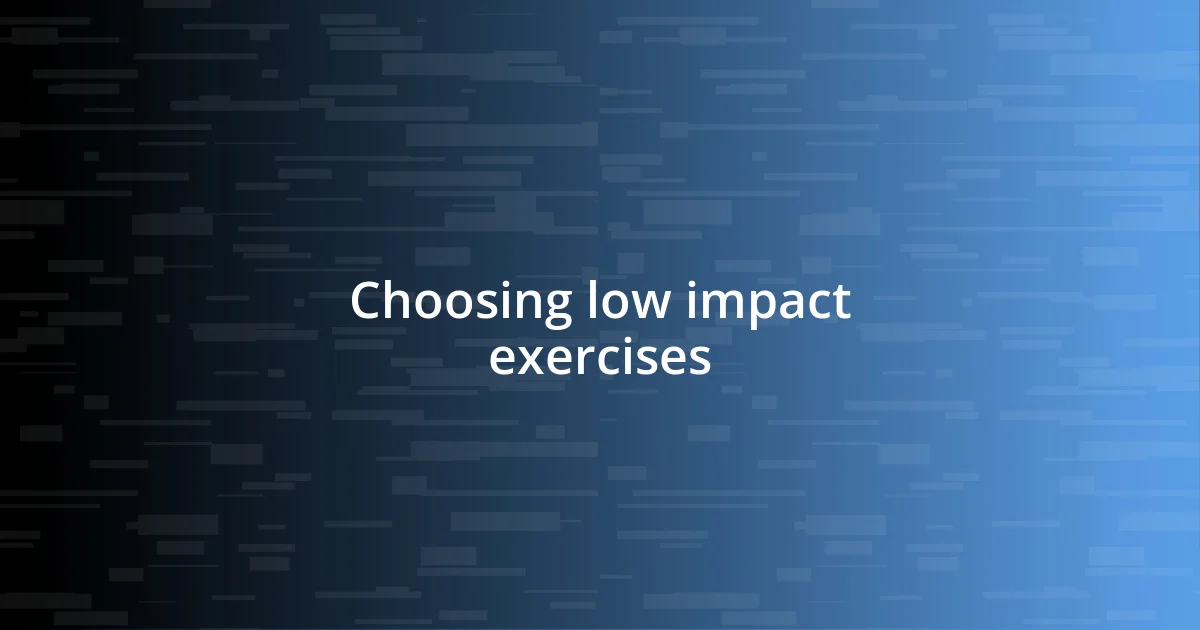
Choosing low impact exercises
Choosing low-impact exercises has been a game-changer for me in managing chronic pain. I remember when I first started exploring options, feeling overwhelmed by choices. It was crucial for me to select activities that wouldn’t exacerbate my pain, yet still allow me to stay active. Low-impact exercises like swimming or cycling have really become my go-to options. They provide a way to move my body without the jarring discomfort that higher-impact activities can sometimes bring.
In my experience, yoga has also opened up a new world of possibilities. The gentle stretching and focus on breathing not only keep my muscles engaged but also help me find moments of calm amidst the pain. I often notice that on days I practice yoga, my body feels more relaxed, and my pain feels somewhat muted. Isn’t it fascinating how something as simple as breath and gentle movement can influence our physical state?
It’s essential to listen to your body when choosing the right exercises. I’ve learned that what works for others might not suit me. For instance, I thought high-energy classes would be beneficial, but they left me feeling drained instead. Finding that balance, where I can challenge myself without causing extra strain, has been empowering.
| Exercise Type | Benefits |
|---|---|
| Swimming | Provides cardiovascular benefits with minimal joint strain. |
| Yoga | Improves flexibility and promotes mental relaxation. |
| Walking | Accessible, improves mood, and enhances overall endurance. |
| Cycling | Builds strength without heavy impact on joints. |
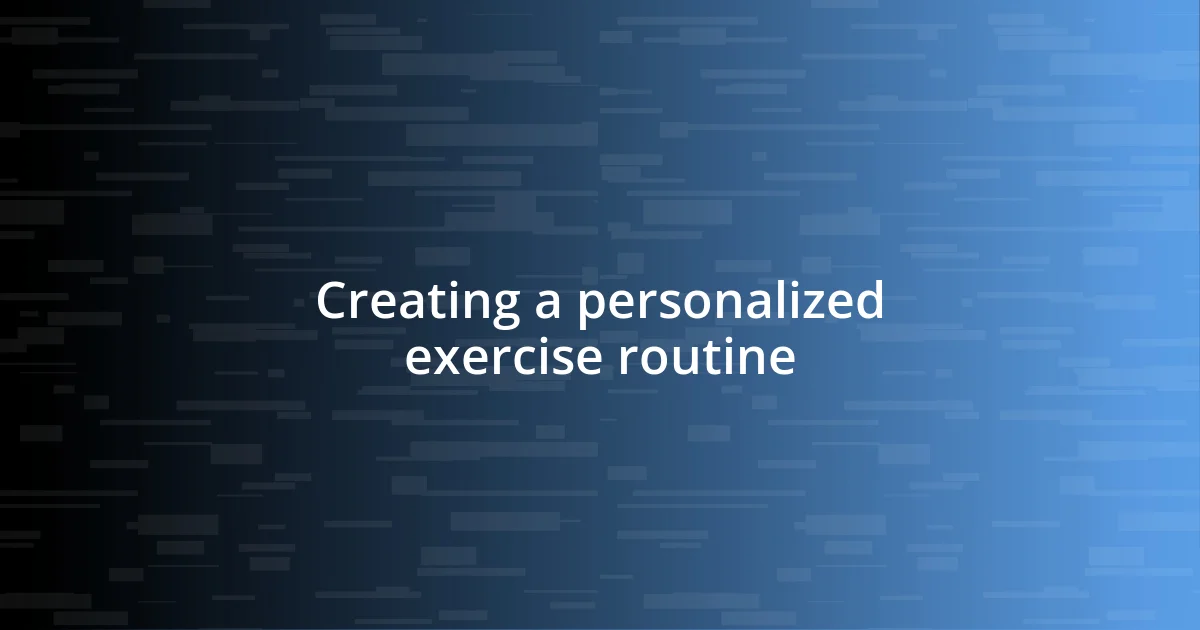
Creating a personalized exercise routine
Creating a personalized exercise routine that accommodates chronic pain is all about listening to your body and recognizing its unique needs. I remember when I first tried to put together a routine; it felt like I was assembling a puzzle with pieces that just didn’t fit. What truly helped me was to jot down activities I enjoyed, regardless of their intensity—like stretching, dancing in my living room, or even gardening. This way, I felt excited about moving my body, rather than viewing it as a chore.
Trial and error played a significant role in shaping my routine. I found that incorporating short, 10-minute bursts of activity throughout the day worked better than trying to power through longer sessions. One afternoon, I decided to turn on my favorite music and dance a bit. Surprisingly, that little boost lifted my spirits and made me realize that movement doesn’t always have to be structured to be effective. Have you ever had those moments where something unexpected brings you joy? That realization inspired me to explore more playful forms of exercise, reinforcing that it’s okay to have fun while staying active.
Ultimately, the key is flexibility—not just in your muscles but in your approach. Sometimes, I shift my routine based on how I’m feeling that day. If I’m experiencing more pain, I might opt for a gentle stretching session instead of a brisk walk. Recognizing that it’s perfectly fine to modify my plans helps me maintain a positive relationship with movement. I’ve learned that routine doesn’t mean rigidity; it’s a fluid concept that can adapt as I navigate my journey with chronic pain. How has your experience been with finding the right balance?
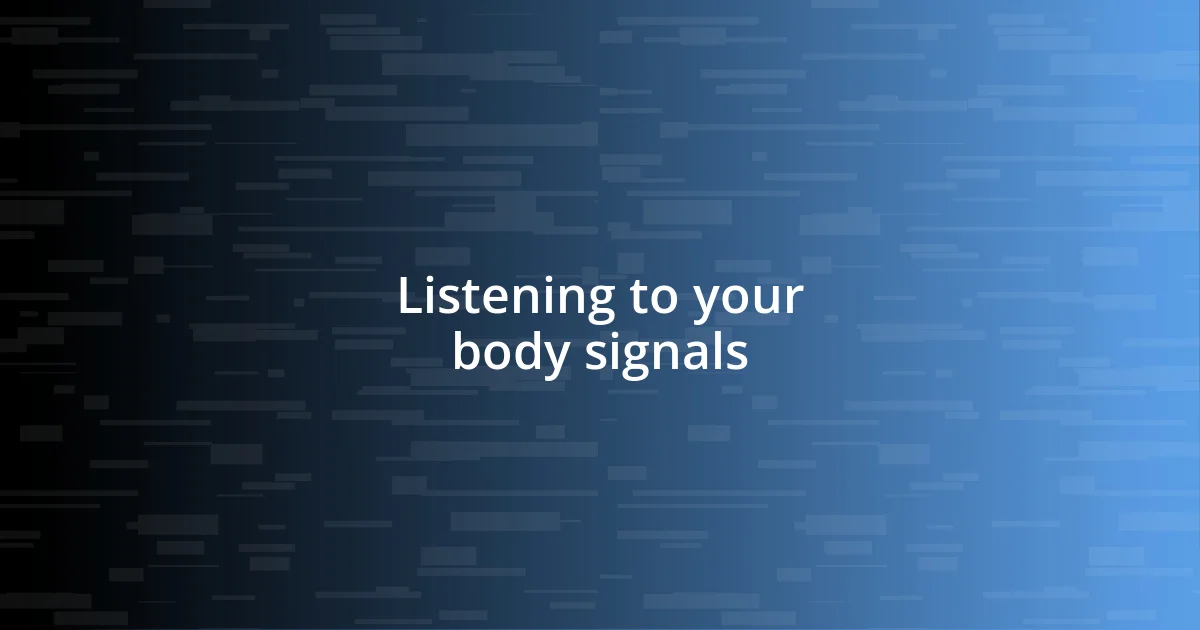
Listening to your body signals
Listening to my body signals has been one of the most enlightening parts of managing chronic pain. In the beginning, I often pushed through discomfort, thinking that was the only way to stay active. But over time, I realized that respecting my body’s cues—like noticing when I feel tingling or increased stiffness—has been crucial. Trust me, when I actually paused to assess what my body needed, I found I could engage in activities that brought me joy without the aftermath of regret.
There are days when I wake up with a heaviness that compels me to reconsider my plans entirely. For example, after a night of intense pain, I may exchange a vigorous workout for a gentle stroll, focusing on the fresh air rather than the calories burned. I remember a particularly painful morning where I chose to sit outside in the sun instead of forcing myself to exercise. That simple act of listening to my body brought a flood of peace and lifted my spirits. Isn’t it incredible how taking a moment to check in with ourselves can reveal a path that respects our limits?
Understanding my body signals has also shaped my social interactions. I’ve learned to communicate my needs to friends and family, which has made outings more enjoyable. One evening out, I had to tell my friends I needed to skip the dance party and opt for a quieter dinner instead. They were surprisingly understanding, and it reminded me of the importance of being open about my limits. Have you ever felt that relief when you finally honored what your body craved? That kind of honesty has transformed how I engage with both my body and my loved ones.
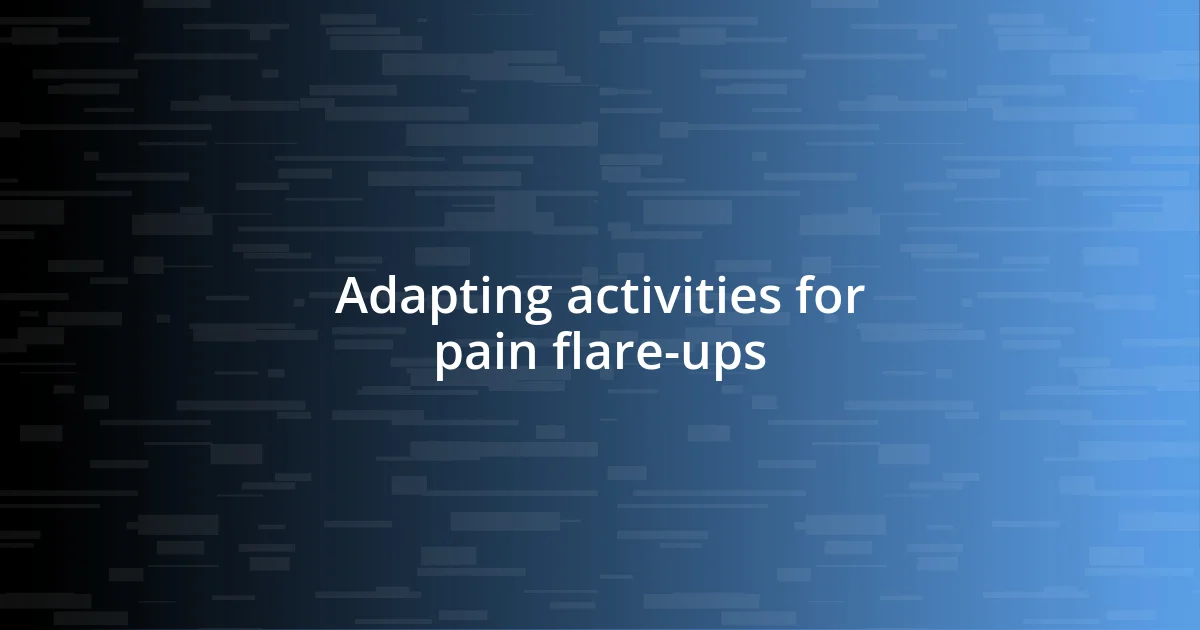
Adapting activities for pain flare-ups
Adapting activities during a pain flare-up requires creativity and a willingness to experiment. I recall a particularly tough week when every movement sent a jolt of pain through my legs. Instead of giving in entirely, I turned to more calming activities. For instance, I found that doing gentle yoga stretches while seated on my bed eased some discomfort. It reminded me that even during the roughest days, I could still find ways to nurture my body without pushing my limits.
Finding alternatives to my usual activities has been a game changer. One day, when a flare-up made it nearly impossible to stand, I pulled out my sketchbook and spent time drawing instead. It surprised me how engaging my mind in a different way could distract me from pain. Have you ever discovered that a simple shift in focus can ease your discomfort? It’s important to recognize that adapting doesn’t mean abandoning movement; it’s about redefining what that movement looks like and allowing ourselves to be flexible.
Another effective strategy I use is modifying household tasks to fit my energy levels. On days when cleaning feels like an uphill battle, I break it into smaller, more manageable parts. I remember one afternoon deciding to organize my bookshelf one shelf at a time; it felt productive and gave me a sense of accomplishment. It turns out that adapting activities around pain flare-ups isn’t about minimizing effectiveness but rather about maximizing joy and fulfillment in whatever way I can engage. How do you adjust your daily routines to honor your body’s needs?
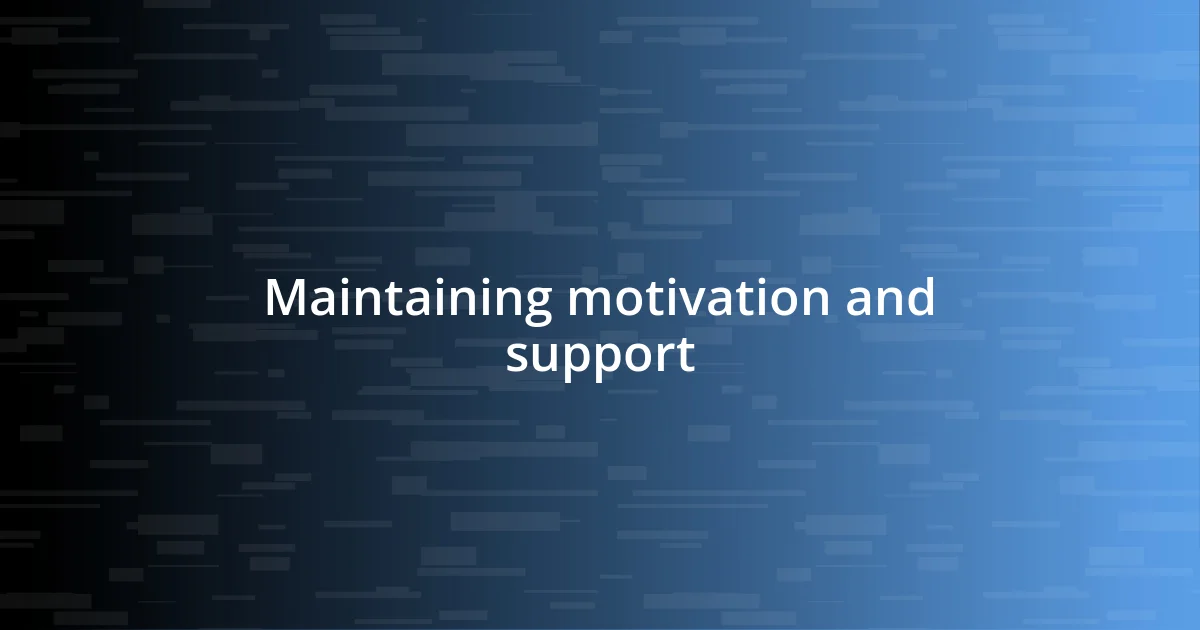
Maintaining motivation and support
Maintaining motivation while managing chronic pain can be incredibly challenging, but I’ve found that surrounding myself with supportive people makes a huge difference. There have been times when I felt like giving up completely, but my friends and family played a pivotal role in lifting my spirits. Just last month, when I was feeling particularly low, my best friend invited me for a light coffee outing, reminding me that connection often brings motivation. Doesn’t a simple chat with someone who understands your struggles reignite your sense of purpose?
Additionally, I’ve learned the importance of celebrating small victories, and having supportive cheerleaders can amplify that joy. I vividly recall the day I completed a walk around the block during a rough week. I was thrilled, but what truly felt rewarding was sharing that accomplishment with my support network. Their encouraging reactions filled me with a sense of pride and renewed motivation to keep pushing forward. Have you ever experienced the power of sharing a small win, only to find that it motivates you beyond your expectations?
One effective method I try to stay motivated is creating a personal accountability system. I often partner with a friend who also faces challenges, and we check in on each other regularly. Recently, we decided to set a goal of trying a new low-intensity workout video once a week. Just knowing that someone else is counting on me helps me stay motivated, even on those hard days when my body doesn’t cooperate. Do you have someone who can hold you accountable on your journey? That shared commitment transforms solitary efforts into a collaborative experience, making every step feel more worthwhile.












